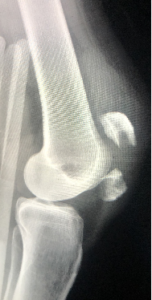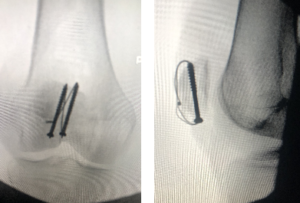Patella Fracture (Broken Kneecap)
What is a Patella Fracture?
A patella fracture is a broken knee cap. This is the oval bone in front of your knee. This usually results from a direct blow or a fall onto a bent knee. The knee cap can be broken into many pieces or just crack slightly depending on the quality of bone and the type of injury.
What does the Patella do?
The patella is an important bone that has several critical functions. This hard structure protects the cartilage of the knee joint. It also connects the thigh muscles to the tibia. Its existence provides 30 percent of the power of the quadriceps muscle. The underside of the knee cap has a thick layer of cartilage that helps the knee to glide smoothly. Irregularity of this surface can result in arthritis.
Diagnosis and Examination
Physical examination is important in the evaluation of these injuries. It is usually the most important way the doctor determines if this injury requires surgery. Displaced fractures usually result in a gap you can feel between the broken bones and loss of the ability to straighten your knee. The doctor will also look for any open wounds over the injury.
X-rays are used to evaluate the location and severity of the broken bone. This helps doctors and patients make an informed decision on treatment. Often two or more x-rays are taken to show the injury pattern. CT scans are recommended at times if more detail is required to determine need for operative fixation.
In some people, the bones in their knee cap never fuse together as they grow. This is known as a bipartite patella. These individuals have perfect function and no problems. They do not need surgery. Sometimes this condition can be mistaken as a fracture. It can be ruled out by getting x-rays of the other knee and with a good physical exam.

Preoperative x-ray of patella fracture.
Non-Surgical Treatment for Broken Kneecaps
If the broken parts of the knee cap are perfectly lined up, if there is no gap on physical exam, and if patients can straighten their leg without difficulty, the patella fracture can be treated without surgery. Braces such as knee immobilizers and hinged braces can be used to hold the bones while they heal. In most cases, patients can walk while the bone heals as long as the brace keeps the knee straight during ambulation. Most patients use crutches, a walker or a cane for stability during the healing process.
If non-operative care is chosen, regular follow-up care for a physical exam and x-rays is important to ensure that the fracture stays in good position and heals appropriately. Cutting down or quitting smoking and tight blood sugar control if you are a diabetic is important for the healing process. One fall or continued lack of compliance with bracing can pull the bone ends apart and result in the need for surgery.
Knees treated in long term braces often become quite stiff. Significant physical therapy and commitment is required for patients to regain their knee range of motion and strength.
Surgical Treatment for Broken Kneecaps
Surgeons may recommend an operation to fix the broken knee cap if the pieces are displaced and if the patient cannot extend the knee. This means that the mechanism is disrupted and needs to be repaired so the patient can return to regular walking and activities.
The patella can be fixed with a tension band construct made of screws and wires or plates and screws. The type of fracture usually dictates what type of metal and surgery needs to be done. In some cases, some bone fragments cannot be repaired and must be removed. The free tendon is then reattached to the remaining bone. In rare cases, the patella is removed completely. Surgery can take 1 to 2 hours. Ideally, surgeons like to perform this surgery within 1-2 weeks of injury. Thus, patients have time to seek a second opinion regarding treatment if more information or additional surgeon input is desired.
It is important to choose your surgeon wisely. Extensive surgical experience can be helpful in achieving a good result and avoiding complications. Collectively, ROC orthopedic surgeons have performed more patella operations than any practice in Northern Nevada and take pride in outstanding surgical results.
After surgery, patients are placed in a knee brace and allowed to walk with the brace on and the knee in extension (straight). The brace can be removed for bathing as long as the patient is careful not to fall or bend the knee too much. Gentle motion is begun early and the range is determined by the surgeon as each repair and patient is different. Gradually this motion is increased and physical therapy is begun around six weeks after the bone has had a chance to begin healing.

Postoperative x-ray of patella fracture.
Surgical Complications
Complications can occur with any surgery, no matter how small. There is always a risk of infection. A dose of antibiotics given prior to surgery helps to make this risk as small as possible. There is always a risk of injury to blood vessels or nerves. This is reduced by having an experienced surgeon involved in your care. Non-compliance with weight bearing restrictions, too much motion or falls can result in the metal ripping out of the bone or the fracture separating. It is always possible that the bone may not heal. This is usually associated with patient non-compliance, diabetes, or use of nicotine like smoking and chewing tobacco.
Outcomes
Most people with patella fractures do very well and return to walking and function. By six weeks, patients are extremely comfortable and usually are released to full activities such as manual labor, skiing and motocross by three months. Aggressive return to activity too early can result in re-fracture, hardware breakage or non-union. Whether treated with surgery or without, these injuries can result in damage to the cartilage of the knee which leads to arthritis.